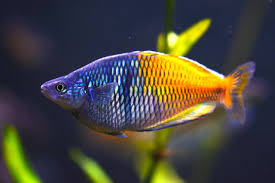
Rainbowfish
Conditions of detention
Rainbowfish are active swimmers that thrive in well-maintained aquariums with plenty of open space. A minimum tank size of 30 gallons is recommended for smaller species, though larger tanks are preferable for groups of larger species. Rainbowfish prefer water temperatures between 72-82°F (22-28°C) and slightly alkaline water with a pH range of 7.0 to 8.0. They do best in tanks with a moderate to strong water flow and appreciate a well-planted environment with some open swimming areas.
Useful Fact: Rainbowfish are schooling fish and should be kept in groups of at least six to encourage natural behavior and reduce stress.
Nutrition and diet
Rainbowfish are omnivorous and thrive on a varied diet. They can be fed high-quality flake or pellet food, supplemented with live or frozen foods such as brine shrimp, daphnia, and bloodworms. They also enjoy vegetable matter, which can be provided through blanched spinach, zucchini, or spirulina-based foods. A balanced diet that includes both protein and plant matter helps maintain their vibrant coloration and overall health.
Useful Fact: Feeding Rainbowfish a varied diet rich in carotenoids, such as those found in live foods and vegetables, can enhance their natural colors.
Health
Rainbowfish are generally hardy but can be susceptible to common freshwater diseases such as ich, fin rot, and velvet, particularly if water quality is poor. They can also suffer from stress-related illnesses if kept in inadequate conditions or if their diet is not varied enough. Regular monitoring of water parameters and maintaining a clean environment are essential for preventing disease.
Useful Fact: Rainbowfish have a longer lifespan when kept in stable water conditions with a varied and nutritious diet, often living up to 5-8 years in captivity.
Grooming and care
Rainbowfish do not require traditional grooming, but their environment needs regular maintenance. Given their active nature, frequent water changes (about 20-30% weekly) and strong filtration are necessary to maintain water quality. It’s also important to provide a clean and well-oxygenated tank, as Rainbowfish are sensitive to poor water conditions.
Useful Fact: Rainbowfish are sensitive to sudden changes in water conditions, so it’s crucial to acclimate them slowly to any new environment to avoid stress.
Education and training
Rainbowfish are not typically trained, but they can learn to recognize their owners and will often come to the front of the tank during feeding times. Their schooling behavior and active swimming make them engaging to observe, and they may respond to the presence of people by gathering near the surface.
Useful Fact: Rainbowfish are most active during the day and can be seen schooling together, often showing off their brightest colors in the morning.
Toys and entertainment
Rainbowfish enjoy exploring their environment and swimming in schools. Providing them with a well-planted tank that includes open swimming areas, rocks, and driftwood gives them plenty of places to explore. They are also known for their playful interactions with tankmates, which can be encouraged by maintaining a dynamic and engaging environment.
Useful Fact: Rainbowfish are fast swimmers and enjoy swimming against currents, so adding a gentle water flow in the tank can stimulate natural behaviors.
Safety
Rainbowfish are peaceful and do well in community tanks with other non-aggressive fish of similar size. However, they can be timid, so it’s important to avoid housing them with larger, aggressive species that might outcompete them for food or harass them. They should be kept in a secure tank with a tight-fitting lid, as they are known to jump, especially when startled.
Useful Fact: Rainbowfish are best kept with other peaceful species like tetras, rasboras, and livebearers, which share similar water requirements and temperament.
Accessories
Essential accessories for a Rainbowfish tank include a reliable filter to maintain water quality, a heater to keep the temperature stable, and a light source that supports plant growth. Rainbowfish appreciate a tank with plenty of open swimming space and moderate planting, including plants that tolerate slightly alkaline water. A secure lid is necessary to prevent jumping.
Useful Fact: Rainbowfish benefit from a well-oxygenated tank with good water circulation, which helps mimic their natural riverine habitat.
Socialization
Rainbowfish are social and thrive in groups. They are generally peaceful and get along well with other community fish of similar size and temperament. Keeping them in schools of at least six helps reduce stress and encourages natural schooling behavior. They are active and enjoy interacting with their tankmates, often displaying their brightest colors during social interactions.
Useful Fact: Rainbowfish display their best colors when kept in groups, where males often compete for the attention of females by showing off their vibrant hues.
Travel and Transportation
When transporting Rainbowfish, use a plastic bag filled with water from their tank and ensure it is well-oxygenated. Transport them carefully to avoid temperature fluctuations and stress. Keep the bag in a dark, insulated container to minimize stress.
Useful Fact: Rainbowfish are sensitive to stress during transport, so it’s crucial to acclimate them slowly to their new environment to reduce the risk of shock.
Behavior and psychology
Rainbowfish are known for their peaceful, social nature and active swimming behavior. They are most comfortable in groups, where they exhibit natural schooling behavior and vibrant coloration. Rainbowfish are generally peaceful and get along well with other non-aggressive species, but they can be shy if kept alone or in small numbers. Their bright colors are most vivid when they feel secure and are in the company of their own kind.
Useful Fact: Male Rainbowfish often display more intense colors when trying to attract a mate or establish dominance within the group, making their interactions particularly colorful.
Legal aspects
There are generally no legal restrictions on owning Rainbowfish, but it’s important to ensure they are sourced from reputable breeders or suppliers. As with all fish, ethical sourcing helps support sustainable practices and ensures the health of the fish.
Useful Fact: Many Rainbowfish available in the aquarium trade are captive-bred, which helps reduce pressure on wild populations and ensures healthier fish for the aquarium.


